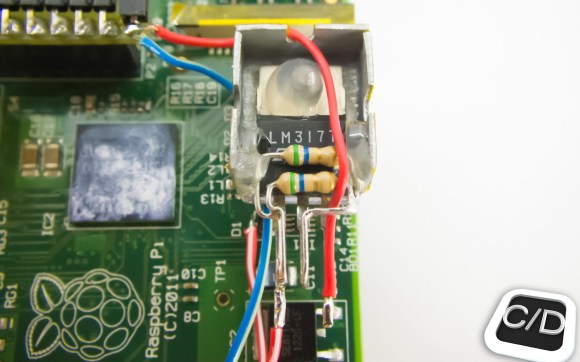
We’ve never tried using an HDMI to VGA converter with Raspberry Pi. We heard they were expensive and have always just used HDMI out (although DVI would be just as easy). Apparently if you have a VGA converter that isn’t powered the RPi board may output unstable video due to lack of current from the connector. [Orlando Cosimo] shows how to fix the problem with a few inexpensive components.
Just this morning we saw a portable PSU using an LM317. This project uses the same part, but in a different way. [Orlando] uses three resistors in parallel to make the LM317 behave like a current regulator (as opposed to a voltage regulator) which will output about 550 milliamps. Input voltage is pulled directly from the 5V line of the microUSB port. The output is injected into the HDMI connector. This will boost the amount of juice available to the unpowered VGA converter, stabilizing the system.
There are a lot of other power hacks out there for the RPi. One of our favorites is pulling the stock linear regulator in favor of a switch mode regulator.
[via Dangerous Prototypes]
















The dropout of an LM317 is at least 1V (plus the current sense resistor) it is all shorted by a diode (max. ~0.8V) so it doesn’t do anything
If you’re interested, Dangerous Prototypes ran this story a while back and there’s some discussion of that same issue.
Link, sorry: http://dangerousprototypes.com/2013/06/26/hdmi-current-booster-fixes-raspberry-pi-video-instability/
Could someone explain maybe how this works exactly? I am a bit confused as to how this acts as a current regulator and what that means….
Useless hack. You want to supply VOLTAGE and not CURRENT to the HDMI plug. Also, the voltage dropout of the 317 is too high to make this work. Waste of time! You could just put a wire between the 5V input and the power pins of the HDMI-connector.
I think the idea was to provide a current limiter in case the field HDMI device shorted. This could be fixed with a polyfuse though.
Think about this unusual configuration some more, or SPICE it. The key is that the current regulator provides less than the HDMI plug requires. This makes it operate at virtually the same voltage as the parallel voltage regulator, serving only to decrease the current needed from the latter.
Of course, should the plug be removed, the voltage will then rise to the max. That obviously should be avoided. ;)
And as for the voltage drop of a linear reg, it’s dependent on current and other factors, rather than a fixed voltage. The datasheets don’t always tell the full story. I trust real-world results more.
spice it? look at the datasheet schematic of the internals of an LM317 and it should be clear that the input out difference can possible be any less that ~1V
Sorry to see you don’t understand that paragraphs are used to group related ideas. The suggestion to SPICE it was in the paragraph about how a current reg and volt reg behave in parallel – not the paragraph about voltage drop – for a reason.
I have personally used the lm317 as a current regulator and I can tell you it drops around 2v (depending on current) in addition to 1.25v dropped over the sense resistors. That extra 1.25v is what makes it a current regulator, you cant deny it. The lm317 regulates the voltage over the resistors (therefore regulating current) to 1.25v. I = 1.25 / R
An lm317 drops 2-3 volts and there is another 1.25v over the sense resistor. You might have a volt left over after the current regulator.
Fail.
Is that hot glue on a heat sink?
The current regulator is in parallel with a diode that has a lower dropout, it’s not as if the regulator is going to be generating any heat.
Then why hot glue the regulator to a heatsink if it is not going to generate any heat?
This must be a joke post … A stab at the pi’s notoriously bad power design.
Both my PI-HDMI to VGA converters, that I bought for half the price that Farnell asks for the same hardware, work just fine directly on the unmodded ‘pi.
The thing is: your 5V powersupply needs to be “reasonably good”. Lots of PI-failures can be tracked down to insufficient 5V.
name and price of the converter please
Search for HDMI VGA on ebay.
I paid just under $20 for the first I got and just over 15 for the second. They dropped in price in the time for shipping and testing. I then immediately decided I wanted another one. It seems they dropped in price even further: The cheapest “buy it now” is now at $7.50….
There are “cables” like: http://www.ebay.com/itm/HDMI-MALE-TO-VGA-HD-15-MALE-Cable-6FT-1-8M-1080P-IK3-/110802906231?pt=US_Video_Cables_Adapters&hash=item19cc5e2c77
that don’t have the required electronics. They don’t work.
Get the ones that have the rounded blob at the end:
http://www.ebay.com/itm/HDMI-Male-to-VGA-Female-Video-SWTG-Cord-Converter-Adapter-for-PC-Laptop-Black-/330938973007?pt=US_Video_Cables_Adapters&hash=item4d0d7ffb4f